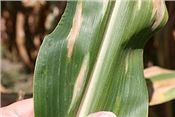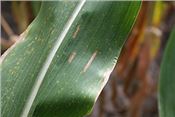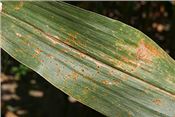Corn Foliage Diseases
DR. LAURA SWEETS
COLUMBIA, MO.
This is shaping up to be another “interesting” year for corn in Missouri and most of the Midwest. Prolonged periods of wet weather and then flooding delayed planting or led to replanting. Overall the corn crop is behind normal. There is also a wide range in growth stages of corn across the state and even in individual fields. We have not received many samples or calls related to corn foliage diseases but with the most recent bout of wet weather, it is likely that corn foliage diseases may begin to show up in fields.
So far the corn fields I have seen have very uneven growth with smaller plants having yellowed lower leaves. The very lowest leaves showed symptoms of anthracnose although the anthracnose was not unusually severe. Anthracnose leaf blight, caused by the fungus Colletotrichum graminicola, usually occurs early in the season on the lower leaves of young corn plants. Anthracnose lesions tend to be brown, oval to spindle-shaped lesions with yellow to pinkish to reddish-brown borders. Lesions may be 0.2 to 0.6 inch in length. Lesions may merge or coalesce to kill larger areas of leaf tissue. Concentric rings or zones are sometimes apparent within the diseased areas of leaf tissue. Lesions may be concentrated towards the leaf tip (or portion of the leaf that was emerged when rain occurred) giving the leaves a fired appearance that might be mistaken for nutrient deficiency or herbicide injury.
The fungus which causes anthracnose leaf blight produces fruiting bodies in the dead leaf tissue. Dark, hair like structures called setae are produced in association with the fruiting bodies. It is possible to see the setae on infected plant material in the field if a hand lens is used.
Anthracnose tends to be most common early in the season on the lower leaves of young corn plants. These leaves may be severely affected, yellow and die prematurely. Generally the disease stops at this point because of drier, warmer weather conditions and is not considered a significant problem. Under favorable weather conditions, the fungus may move up the plant causing foliage symptoms on higher leaves. If favorable weather conditions occur mid-season (especially wet), anthracnose may actually move up to the ear leaf. The anthracnose fungus can also cause top dieback and stalk rot later in the season. High temperatures and extended periods of wet weather favor anthracnose. Anthracnose leaf blight is more likely to occur if corn is planted following corn.
In a normal year anthracnose leaf blight in Missouri is not serious and would not warrant a fungicide application. It is a little too early in the season to know how severe anthracnose will be or to know if it might spread beyond the very lowest leaves on the plants. Following the weather patterns over the next several weeks and keeping an eye on disease development or lack of development will be important.
We have also received samples with symptoms suggestive of either Holcus leaf spot or herbicide injury. Holcus leaf spot is caused by the bacterium Pseudomonas syringae pv. syringae. Lesions are usually oval to elliptical and range in size from 0.25 to 1.0 inch. Initially they are dark green and water-soaked. Later they become dry and turn light brown with a reddish margin.
The bacteria that cause holcus leaf spot are spread by wind-driven rain or splashing rain, so outbreaks frequently occur several days after a rainstorm or storm with strong wind-driven rains. Since holcus leaf spot is caused by a bacterium, common corn fungicides will have little effect on this disease.
We are beginning to receive corn samples with northern corn leaf blight, gray leaf spot and common rust. However, thus far, these corn foliage diseases do not appear to be as severe as other states in the Corn Belt are reporting. It will be important to scout for these and other corn foliage diseases over the next few weeks.
The fungus that causes northern corn leaf blight has undergone a number of name changes over the years but the most recently accepted name for the asexual stage of the pathogen is Exserohilum turcicum.
Northern corn leaf blight lesions are long, elliptical, grayish green lesions ranging from 1.0 to 6.0 inches in length. As the lesions mature they may become more tan in color. During damp or humid weather, dark olive green to black spores may be produced across the surface of the lesions. Northern corn leaf blight usually begins on the lower leaves of the plants. As the season progresses, nearly all leaves of a susceptible plant may be covered with lesions, giving the plants the appearance it has been injured by frost.
Northern corn leaf blight is most severe when temperatures are in the range of 64 to 80 degrees F and when prolonged periods of dew or wet, overcast weather keep the foliage wet for extended periods of time. Hybrids may vary greatly in their susceptibility to northern corn leaf blight.
Gray leaf spot, caused by the fungus Cercospora zeae-maydis, has become a serious problem across much of the Corn Belt. Initially, small, round to oval, reddish brown lesions with yellow haloes develop between the leaf veins. These lesions increase in size, but since growth of the causal fungus is restricted by leaf veins, the lesions develop parallel edges which give them a rectangular or blocky appearance.
Older lesions are pale brown to reddish brown in color and blocky to rectangular in shape. They may range from 0.5 to 2 or more inches in length. During periods of wet weather or high humidity, the pathogen may sporulate across the lesion, giving the lesion a grayish cast. Lesions may merge, resulting in large areas of dead leaf tissue. Lesions typically develop first on lower leaves but under favorable conditions, extensive leaf blighting over the entire plant may occur.
The fungus that causes gray leaf spot survives in infested residues left on the soil surface. Gray leaf spot is more severe when corn is planted after corn. Spores produced on infested residues are spread by wind or splashing rain to corn plants. Prolonged periods of overcast weather, heavy dews or fog favor the development of gray leaf spot.
Although gray leaf spot may not be evident in a field until after silking, the disease can build up rapidly during the latter part of the season, completely blighting leaves and causing premature death of plants. Corn hybrids vary greatly in their susceptibility to gray leaf spot.
Common rust is caused by the fungus Puccinia sorghi. Rust pustules begin as small, circular, light green to yellow spots in the leaf tissue. These lesions develop into circular to elongate, golden-brown to reddish-brown, raised pustules. The rust pustules may be in bands or concentrated patches on the leaf as a result of infection that occurred while the leaf was still in the whorl.
The pustules quickly rupture to reveal masses of rusty brown spores. As plants mature, the pustules become brownish black in color. Common rust pustules may develop on both upper and lower leaf surfaces as well as on leaf sheaths, husks and stalks. When rust is severe, leaves and leaf sheaths may yellow and die prematurely.
Puccinia sorghi does not survive on infested residues left in the field. Rather infection during a growing season occurs as spores are blown in from more southern locations. The incidence and severity of common rust during a season depends in part on how early in the season rust inoculum reaches Missouri. The earlier in the season that rust spores arrive, the greater the potential for rust problems to develop.
Temperatures in the range of 60 to 77 degrees F and high relative humidity favor the development of common rust. Younger leaf tissue is more susceptible to infection than is older, mature leaf tissue. Most commercial corn hybrids are fairly resistant to common rust.
Management of Corn Foliage Diseases:
Generally speaking with the corn foliage diseases, the later in the season (especially the longer after pollination) that the foliage disease becomes established, the lower direct yield losses will be. Highest yield losses occur if diseases such as rust or gray leaf spot develop prior to pollination. Also, most of the corn foliage diseases are favored by extended periods of free moisture on the leaf surfaces. This moisture can be from rain, overhead irrigation or heavy dews that stay late in the day. Fields with poor air movement, river bottom fields or shaded portions of fields may also have higher levels of corn foliage diseases.
Most of the control recommendations for minimizing losses due to corn foliage diseases are preventative measures such as planting resistant hybrids, rotating crops so the corn doesn’t follow corn in the same field or tillage to reduce the amount of infected residue left on the soil surface. Several fungicides are labeled for use on corn to control foliage diseases. See the 2015 Missouri Pest Management Guide: Corn, Grain Sorghum, Soybean and Winter Wheat M171 for fungicides labeled for use on field corn. Printed copies of this bulletin are available from the Extension Publications Distribution Center, 2800 Maguire Blvd., Columbia, MO, 573-882-7216 or online at www.extension.missouri.edu/p/M171 .
Carl Bradley, former Extension Plant Pathologist at the University of Illinois and now at the University of Kentucky, wrote a last article for the University of Illinois Pest Alert that contained information on the results of his foliar fungicide trials over the last several years. See http://bulletin.ipm.illinois.edu/?p=3330 for that article.
In making the decision on whether or not to apply a foliar fungicide to corn it is important to consider the yield potential of each individual field. If fields are uneven and struggling because of wet conditions, foliar fungicides are less likely to give significant increases in yield. If nitrogen loss is a problem again because of wet conditions, it may be more beneficial to correct the nitrogen deficiency than apply a fungicide. Foliar fungicides may give greater yield increases on susceptible hybrids than on hybrids with resistance to the foliage disease present. With foliar fungicides it is important to be scouting fields so that products are applied before the disease has built up to high levels. Later planted fields which will have plants at earlier growth stages later in the season may also benefit more from fungicide application if diseases are occurring than early planted fields which are at more advanced growth stages.
With the wide range in planting dates and plant vigor across the state it is impossible to make blanket assessments of the incidence or severity of corn foliage diseases or to make statewide management recommendations. Individual fields need to be monitored for stand, vigor and yield potential, for other issues such as nitrogen loss or weed escape problems, for the foliage diseases present and the severity of those diseases as well as for the forecast weather conditions in the area before deciding to apply a foliar fungicide.
Fields with high levels of various foliage diseases may also show higher levels of stalk rot this fall. As harvest approaches, check fields which have had foliage disease problems for stalk rot and try to harvest problem fields promptly. ∆
DR. LAURA SWEETS: Extension Associate Professor, Division of Plant Sciences, University of Missouri

Figure 1: Northern Corn Leaf Blight

Figure 2: Gray leaf spot and common rust

Figure 3: Common rust